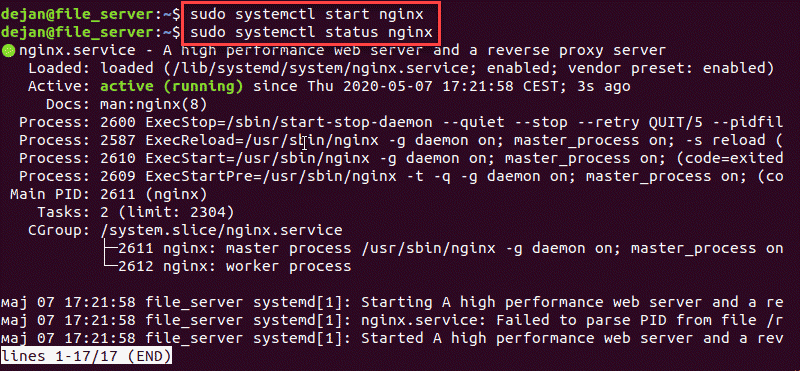Nginx Conflicting Server Name
NGINX is a popular open-source web server and reverse proxy server. It is known for its high performance, scalability, and reliability. When configuring NGINX, one crucial aspect to consider is server name conflicts. Server name conflicts occur when there are multiple server blocks with similar server names or conflicting configurations, resulting in NGINX being unable to determine the correct server block to process requests.
Identifying the Causes of Server Name Conflicts in NGINX Configuration
Server name conflicts can arise due to several reasons. It is essential to identify these causes to effectively resolve them. Some common causes include:
1. Duplicate Server Names: One cause of server name conflicts is having multiple server blocks with the same server name. NGINX matches incoming requests based on the server_name directive, and when there are duplicates, NGINX cannot determine which block to handle the request.
2. Default Server Configuration: NGINX uses a default server configuration to handle requests that do not match any explicitly defined server_name. If multiple server blocks are configured as default, conflicts can occur.
3. Incorrect Routing Configuration: Incorrect configuration in the routing logic, such as missing or misplaced directives, can lead to server name conflicts. It is crucial to ensure that the routing configuration aligns with the intended functionality.
Resolving Server Name Conflicts through Correct NGINX Routing Configuration
To resolve server name conflicts in NGINX, it is crucial to ensure correct routing configuration. Follow these steps to resolve conflicts effectively:
1. Unique Server Names: Make sure that each server block has a unique server_name directive. This ensures that NGINX can identify the correct server block to handle requests based on the requested domain name.
2. Default Server Configuration: If multiple server blocks are set as the default server configuration, NGINX will report conflicts. To resolve this, ensure that only one server block is configured as the default server. This server block will handle requests that do not match any explicitly defined server_name.
3. Proper Routing Logic: Review the routing logic to ensure that directives, such as location and proxy_pass, are correctly placed and configured. Misconfigurations in routing logic can result in conflicts.
Handling Multiple Server Blocks with Conflicting Server Names in NGINX
In some cases, you may need to handle multiple server blocks with conflicting server names, particularly when managing multiple domains or subdomains. To handle this, you can use the wildcard server_name directive to create more flexibility in your configuration.
Implementing Wildcard Server Names to Prevent Conflicts in NGINX
Wildcard server names allow you to specify a pattern instead of explicitly defining each domain or subdomain. The wildcard symbol (*) is used to match any subdomain or domain. Here’s an example:
“`
server {
server_name *.example.com;
…
}
“`
In the example above, any subdomain under “example.com” will be matched, allowing you to handle requests for multiple subdomains without conflict.
Troubleshooting Common Errors Associated with Server Name Conflicts in NGINX
While configuring NGINX, you may encounter some common errors related to server name conflicts. Let’s discuss a few of them and how to troubleshoot them:
1. “Conflicting server name _” on 0.0.0.0:80, ignored”: This error indicates that NGINX has encountered duplicate server names. To resolve this, review your configuration file and ensure that each server_name directive is unique.
2. “A duplicate default server for 0.0.0.0:80”: This error occurs when multiple server blocks are configured as the default server. To fix this, ensure that only one server block is set as the default server.
3. “nginx: (emerg) bind() to 0.0.0.0:80 failed (98: Address already in use)”: This error suggests that NGINX is unable to bind to the specified IP address and port because another process is already using it. To resolve this, you need to identify the process using the port and either stop it or reconfigure NGINX to use a different port.
Best Practices to Avoid Server Name Conflicts and Ensure Smooth NGINX Operation
To avoid server name conflicts and ensure a smooth NGINX operation, it is essential to follow these best practices:
1. Plan Your Configuration: Before configuring NGINX, plan your server block structure and consider any potential conflicts. This will help you design a clean and organized configuration.
2. Use Unique Server Names: Always ensure that each server block has a unique server_name directive to prevent conflicts.
3. Regularly Review and Test Configuration: Regularly review and test your NGINX configuration for any conflicts or misconfigurations. This will help proactively identify and resolve any issues before they impact your server’s performance.
4. Be Mindful of Default Server Configuration: Avoid setting multiple server blocks as default, as it can lead to conflicts. Only one server block should be designated as the default server.
5. Leverage Wildcard Server Names: When managing multiple domains or subdomains, consider using wildcard server names to handle requests flexibly and prevent conflicts.
6. Monitor NGINX Logs: Monitoring NGINX logs can provide insights into any potential conflicts or errors. Regularly check the logs to ensure smooth operation and promptly address any issues that arise.
FAQs
Q: What is the role of the server_name directive in NGINX?
A: The server_name directive in NGINX specifies the domain name or names that should match the server block. It plays a crucial role in determining which server block should handle incoming requests.
Q: Can I have multiple server blocks with the same server name?
A: No, having multiple server blocks with the same server name will result in conflicts. Each server block should have a unique server_name directive.
Q: How can I troubleshoot NGINX errors related to server name conflicts?
A: Troubleshooting NGINX errors related to server name conflicts involves reviewing your configuration file, ensuring unique server names, and fixing any misconfigurations. Monitoring NGINX logs can also provide helpful information.
Q: How can I handle multiple server blocks with conflicting server names?
A: To handle multiple server blocks with conflicting server names, consider using wildcard server names to create more flexibility in your configuration.
Q: Are there any best practices to avoid server name conflicts in NGINX?
A: Yes, some best practices include planning your configuration, using unique server names, regularly reviewing and testing your configuration, being mindful of default server configuration, leveraging wildcard server names, and monitoring NGINX logs.
In conclusion, server name conflicts in NGINX can occur due to various reasons such as duplicate server names, conflicting default server configurations, or incorrect routing configurations. Resolving these conflicts requires careful configuration planning, unique server names, proper routing logic, and the use of wildcard server names when necessary. By following best practices and regularly monitoring the NGINX configuration, you can avoid conflicts and ensure smooth operation.
Nginx Conflicting Server Name \”\” On 0.0.0.0:80, Ignored
Keywords searched by users: nginx conflicting server name Nginx server name, Conflicting server name _” on 0.0 0.0 80, ignored, A duplicate default server for 0.0 0.0 80, Server_name nginx IP address, Nginx check domain name, Nginx: (emerg) bind() to 0.0 0.0 80 failed (98: Address already in use), Systemctl status nginx, Config nginx domain
Categories: Top 88 Nginx Conflicting Server Name
See more here: nhanvietluanvan.com
Nginx Server Name
Introduction:
In the world of web servers, Nginx has emerged as a popular choice due to its high performance, efficiency, and scalability. When setting up multiple websites or applications on an Nginx server, the server name directive plays a vital role in ensuring proper routing of incoming requests. In this article, we will delve deeper into Nginx server name configuration, explore its functionality, and address frequently asked questions to help you optimize your server configuration.
Understanding Nginx Server Name:
The server name directive in Nginx allows you to define the server names to which the incoming requests should be matched. It helps Nginx determine which server block should handle a particular request, especially in scenarios involving multiple domains or subdomains on the same server.
Basic Syntax:
The syntax for defining server names in Nginx is straightforward:
“`
server {
listen 80;
server_name example.com www.example.com;
…
}
“`
Here, the `server_name` directive is followed by a space-separated list of server names to be matched. In the example above, requests directed to either `example.com` or `www.example.com` would be routed to this specific server block. You can add as many server names as required, separated by spaces.
Wildcard Server Names:
Nginx allows the use of wildcard server names, denoted by an asterisk (*) or a tilde (~) character. An asterisk denotes a wildcard that matches any number of characters, while a tilde denotes a case-insensitive match.
“`
server {
listen 80;
server_name *.example.com;
…
}
“`
In the above example, any subdomain of `example.com`, such as `sub1.example.com` or `sub2.example.com`, will be matched and directed to this server block.
Order of Server Name Matching:
When processing incoming requests, Nginx follows a specific order to determine the appropriate server block. It attempts to match the server name in the following order: exact (non-wildcard), wildcard, and regular expressions. Therefore, if a request matches both an exact server name and a wildcard or a regular expression, Nginx gives precedence to the exact match.
Best Practices for Nginx Server Name Configuration:
To ensure optimal performance and maintainability of your Nginx server configuration, consider the following best practices:
1. Use an explicit default server block: Create a default server block to handle unmatched requests. Include a specific server_name directive to clearly define it as the fallback block.
2. Prioritize exact server names: Organize your server blocks in order of specificity. Place server blocks with exact server names higher up in your configuration file to ensure matches are handled without the need for wildcard or regular expression checks.
3. Minimize the use of wildcard server names: While wildcard server names can simplify configuration, excessive use can impact performance. Use them judiciously, restricting their application to appropriate scenarios, such as handling dynamic subdomains.
4. Implement regular expressions with caution: Regular expressions offer powerful pattern matching capabilities, but they can be computationally expensive. Use them sparingly and with caution, as they may impact server performance.
FAQs:
Q1. Can I use multiple `server_name` directives within a single server block?
Yes, you can include multiple `server_name` directives within a single server block, each specifying a different server name to be matched.
Q2. Are server names case-sensitive in Nginx configuration?
No, Nginx performs case-insensitive server name matching by default. Thus, `example.com`, `EXAMPLE.com`, and `eXaMpLe.com` would be considered equivalent.
Q3. What is the difference between `=` and `~` in the server_name directive?
The `=` sign signifies an exact match, while the `~` sign denotes a case-sensitive regular expression match. For instance, `server_name = example.com` matches exactly `example.com`, whereas `server_name ~ \.com$` matches any server name ending with `.com`, such as `www.example.com` or `test.com`.
Q4. How can I redirect requests from one server name to another?
To redirect requests from one server name to another, you can use the `return` or `rewrite` directives within the appropriate server block. This allows you to specify the desired URL or domain to which the request should be redirected.
Conclusion:
The proper configuration of Nginx server names is crucial for effective routing of incoming requests in scenarios involving multiple domains or subdomains. By understanding the functionality and best practices of Nginx server name configuration, you can optimize your server setup, maximize performance, and ensure smooth operation for your websites or applications.
Conflicting Server Name _” On 0.0 0.0 80, Ignored
In the world of technology, server names play a crucial role in identifying and accessing specific systems. They act as a unique identifier for servers, allowing users to connect and interact with them. However, there are instances where conflicts arise due to server names, and specifically, the term “on 0.0 0.0 80, ignored” has garnered attention. In this article, we will explore the concept of conflicting server names, understand what “on 0.0 0.0 80, ignored” means, and address some frequently asked questions to provide a comprehensive understanding of this topic.
Understanding Conflicting Server Names:
Server names, also referred to as hostnames or domain names, are a crucial part of the internet infrastructure that enables users to access specific servers and websites. These names should be unique to avoid conflicts or confusion. However, in some cases, multiple servers might end up having the same name, resulting in conflicts.
Conflicting server names can lead to a range of issues. For instance, users might run into trouble accessing a particular server if its name conflicts with another server in the network. Conflicts can occur due to various reasons, such as duplicate configurations or errors in domain name system (DNS) management.
Exploring “On 0.0 0.0 80, Ignored”:
The term “on 0.0 0.0 80, ignored” has gained attention within the tech community concerning server name conflicts. To understand its meaning, we need to break it down. “On” indicates the state of a server, implying that something is occurring or happening with it. “0.0 0.0” refers to an IP address commonly known as the null or unspecified address. Lastly, “80” represents the well-known port for web traffic (HTTP).
When combined, “on 0.0 0.0 80, ignored” suggests that there is a conflicting server name with an invalid or unspecified IP address, causing the server to ignore connections on port 80. This conflict can prevent users from accessing the services hosted on the affected server.
Explaining the Impact and Resolution:
Conflicting server names can create various issues, ranging from the server being unreachable to causing misdirected traffic. Imagine a scenario where two servers in the same network have the same name but different IP addresses. This can create confusion for users, as their connection requests might accidentally reach the wrong server.
To address the conflicts, system administrators need to identify the root cause. One way to do this is by reviewing the DNS configuration and ensuring that all server names are unique. DNS records should be checked to guarantee accurate mapping between server names and IP addresses. By resolving conflicting server names, administrators can restore proper communication and access to the affected servers.
FAQs:
Q: How can conflicting server names impact connectivity?
A: Conflicting server names can lead to connectivity issues, preventing users from accessing services or websites hosted on the affected servers. It can also cause misdirected traffic, leading to confusion and potential security concerns.
Q: Why does “on 0.0 0.0 80, ignored” appear in server name conflicts?
A: “On 0.0 0.0 80, ignored” is a descriptor that indicates a server’s state when it encounters a conflict. It implies that the affected server is ignoring connections on port 80 due to a conflicting server name with an unspecified IP address.
Q: How can conflicting server names be resolved?
A: Resolving conflicting server names requires identifying the root cause of the conflict, typically through a review of the DNS configuration. Administrators should ensure that each server has a unique name and that DNS records accurately map these names to their respective IP addresses.
Q: Are there any potential security risks associated with server name conflicts?
A: While server name conflicts themselves might not pose direct security risks, they can indirectly impact security. Misdirected traffic might expose sensitive information to unintended recipients, potentially compromising data confidentiality. It is important to resolve conflicts promptly to maintain a secure network environment.
In conclusion, conflicting server names, such as “on 0.0 0.0 80, ignored,” can disrupt network connectivity and hinder users’ access to services hosted on affected servers. By understanding the nature of the conflict and following proper resolution steps, system administrators can ensure smooth operations and enhance overall network security.
Images related to the topic nginx conflicting server name

Found 33 images related to nginx conflicting server name theme










Article link: nginx conflicting server name.
Learn more about the topic nginx conflicting server name.
- nginx error “conflicting server name” ignored – Stack Overflow
- Conflicting server name “mydomain.com” on 0.0.0.0:80 …
- Nginx conflicting server name for subdomain
- Redirect old url to new with NGINX conflicting server name error
- conflicting server name “” on 0.0.0.0:80, ignored – Marc.info
- Server Name Conflict Resolution & LE SSL Resolution – Help
- nginx: [warn] conflicting server name “sub.domain.com” on 0.0 …
- Server names – Nginx.org
See more: nhanvietluanvan.com/luat-hoc